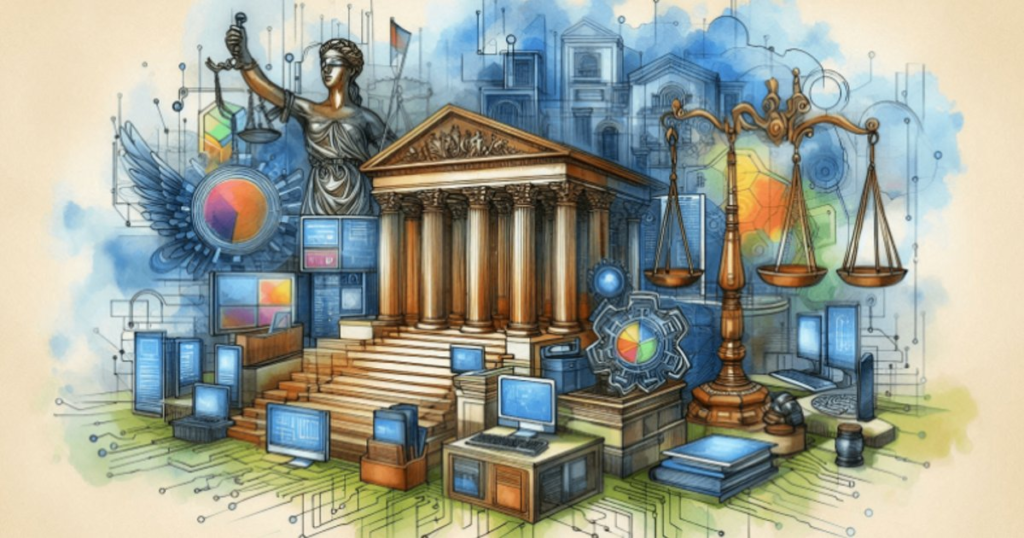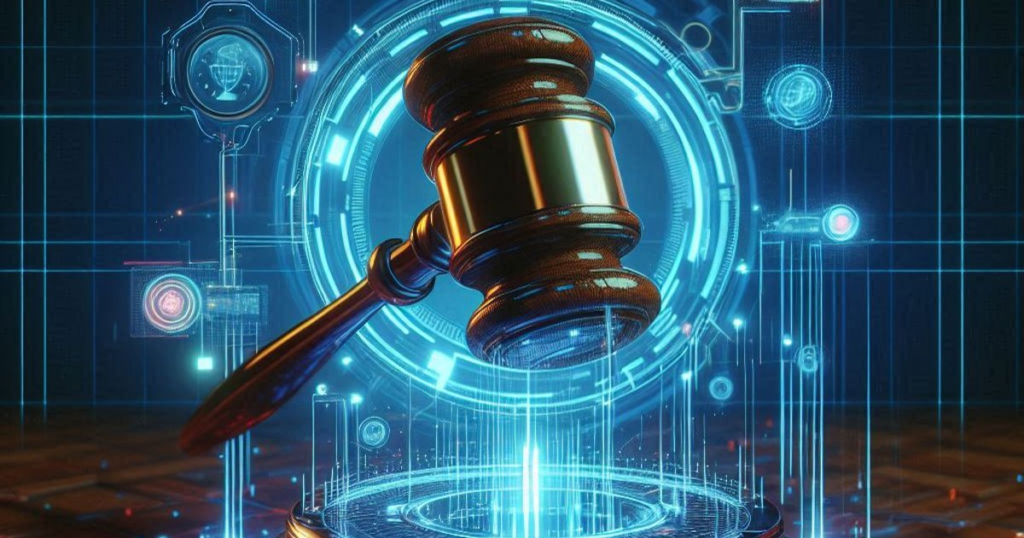
Abstract
The objective of this paper is to highlight the techniques involved in legal research and analysis. The author has discussed several published research works that demonstrate how Artificial Intelligence is transforming the Indian judiciary. To build any AI-based application, knowledge capture is an essential step in training the models. This paper mainly focuses on techniques that facilitate the extraction and capture of knowledge within legal documents. NLP techniques such as dependency graphs and word clouds help in understanding the major themes and contexts present in legal texts. In the future, this work can be extended to develop datasets for training AI-based algorithms. This paper also focuses on the various AI-based tools used by the Indian judiciary and how they assist legal professionals in performing legal research more efficiently and accurately.
Keywords: Legal research, Artificial Intelligence, Natural language processing, Ontology, LLM.
Introduction
The legal system serves as a framework through which society upholds the rules of law and order. With the introduction of Artificial Intelligence (AI) in almost every sector, the legal landscape is also undergoing significant transformation. Though, AI-based techniques have been introduced in healthcare, e-commerce, banking, education, business, management, and several other sectors. In legal research, AI is applicable in all areas including case administration to case based research. The emergence of virtual platforms since COVID-19 has significantly changed the way the legal research has been handled by the professionals. General people can check their case status online. Courtrooms have shifted to virtual platforms. In 1956, John McCarthy introduced Artificial Intelligence. Significant data waste resulted from previous systems’ inability to effectively handle the enormous volumes of data being generated with the onset of the Big Data era in 2009. This problem was addressed in part by the advancement of Big Data technologies. With the advent of Generative AI, Federated Learning, and other cutting-edge methods, the AI era then began and continued to develop.
Numerous AI-based algorithms are being developed every day to introduce new approaches for handling data and deriving meaningful insights to solve complex business problems.
AI can be used to solve many problems and enable faster delivery of services by legal professionals. Major issues such as case backlogs, limited access to legal aid, and the need for accurate summarization of legal cases to extract key information for drafting documents can all benefit from AI-based solutions. In all these scenarios, developing an AI-based application to assist legal professionals requires capturing and integrating domain-specific legal knowledge. This paper primarily discusses AI-based techniques for capturing the knowledge embedded in legal documents. It is well established that when developing an AI application for assistance in any domain, capturing domain-specific knowledge is essential for effective model training. Therefore, this paper focuses on techniques that can be applied to legal texts as a preliminary step toward knowledge extraction. Such approaches can further help identify the parameters required to train AI models designed to assist legal professionals.
Related Studies
It can be difficult for professionals to choose the most reliable and pertinent sources due to the overwhelming amount of information that is available. Since, the subscription cost of law journal is mostly high. Training and adaptation are necessary for new technology and instruments, which might be challenging for people used to more conventional research techniques.
Artificial intelligence techniques have been used to legal documents in a number of published research papers to support legal professionals. Tasks like information retrieval, text extraction, and document summarizing are frequently included in this type of support. In India and around the world, sophisticated methods like knowledge graphs, deep learning models, and large language models (LLMs) have shown great success in extracting domain information from legal documents. For text analytics and legal document summarization, a number of transformer-based models, including BERT and Legal-BERT, are frequently utilized.
India has seen a notable increase in the use of AI in the courts during the digitization era. Digital infrastructures like hybrid hearings, e-filing systems, online case status tracking, digital judgment repositories, and online fee payment facilities have been introduced by the Supreme Court and other High Courts.
To some extent, lower courts are also attempting to adopt digitization by providing case status updates through e-portals. In several lower courts, documents are available in local languages. For developing such applications, structured data is highly essential. Capturing and extracting the major context from legal documents is therefore a crucial task. Techniques such as dependency graphs, word clouds in NLP, ontologies, and large language models (LLMs) are proving to be game changers in understanding the context of legal data. The subsequent section discussed AI-based techniques used to extract the major context of legal cases.

AI concepts to understand and capture knowledge from legal text
Natural Language Processing (NLP)
Legal professionals primarily focus on identifying key information through legal research for case analysis. Similarly, Natural Language Processing (NLP) is a technique that enables machines to understand content presented in natural language. Nowadays, NLP is supporting several judicial services and transforming legal practice by efficiently extracting essential information from legal documents.
Several pre-trained models such as BERT, GPT, RoBERTa, and domain-specific variants (e.g., Legal-BERT, Lawformer) are fine-tuned on legal corpora to capture legal terminology, context, and semantics. These models significantly improve tasks such as case similarity detection, document summarization, and judgment prediction.
Another framework combines large language models with legal knowledge graphs to help understand the connections between entities present in legal cases [9]. This approach can help identify crimes and the individuals associated with them by representing relationships through nodes and edges in a graph. The concept is widely used in computer forensics to analyze the connections between a crime and the accused. Earlier, this process was performed manually using pen and paper, but with the help of NLP, systems can now automatically detect these relationships, providing a clearer and more comprehensive view of the case.
Ontology
Ontology is another concept through which domain knowledge can be captured with the help of formal rules. In many countries, legal ontologies are widely used to understand the underlying knowledge embedded in legal cases. In order to extract important context and collect domain knowledge from legal documents, dependency graph techniques in Natural Language Processing (NLP) are being used more and more. This makes it possible to create AI systems that support legal professionals. These techniques offer sophisticated reasoning, retrieval, and explain ability by representing legal knowledge as linked entities and relationships. In order to guarantee that the structured knowledge appropriately reflects legal notions like responsibilities, obligations, and jurisdictions, the extracted dependency graphs are frequently in line with legal ontologies and taxonomies.
LLM
Nowadays, transformer-based models are widely used for various legal research purposes. LLM-based tools support tasks such as summarization of legal documents, judgment prediction, policy analysis, and more. Some LLM models are trained on domain-specific legal data to perform tasks like legal text analytics.
Another area that is recently evolving is automated legal reasoning. Machine learning models such as Artificial Neural Networks (ANNs) have also achieved high accuracy in predicting outcomes based on legal text extracts.
Explainable AI
Explainable AI (XAI) is enhancing transparency and trustworthiness in legal research and analysis. Deep learning models used for legal decision-making (e.g., in trademark law) are now being augmented with interpretable intermediate layers, enabling both high performance and clearer insight into the model’s reasoning process. Since legal decisions require clear and well-structured reasoning, the use of XAI greatly supports transparency in the decision-making process.
From the AI-based techniques discussed above mostly, it is evident that such methods are being widely applied in legal systems across the world, including the EU and the UK. However, the adoption of these concepts in the Indian legal system is still in progress. There is significant scope for applying AI techniques in various areas of legal research in India.
The subsequent section discusses some of the tools currently used by the Supreme Court and High Courts, along with their integration into other legal research platforms.

Legal AI based Tools in Indian Judiciary
In India, the AI for Viksit Bharat initiative launched by the government aims to provide AI-based services across various sectors, creating numerous job opportunities. In legal research, significant analytical thinking is required to extract the major context of cases. In this area, AI can assist by identifying and extracting relevant information from case documents more efficiently. Table 1 is depicting some tools used by Indian judiciary to assist legal professionals with higher efficiency.
| Tools | Technology used | Purpose |
AI-Vakeel | Large Language Models(LLM Based Models) | AI Vakeel is a tool used by legal professionals and the general public to provide smart legal query resolution through natural language responses. It is primarily used as a chatbot that offers general legal advice based on applicable laws. Previously, queries were processed using keyword-based search; however, with the integration of LLM models, users can now receive assistance simply by entering their case queries or case details.It is a subscription-based, AI-powered legal assistant designed to streamline and enhance the legal research process. |
E-Portal for Case Management | Data Repository | The E-Portal Case Management system is a tool used for automated document analysis, extraction of key information from legal cases, and case classification. This portal primarily assists in managing cases from the filing stage to the final hearing. It also provides updates on recent developments in cases across the Supreme Court and various High Courts. |
SUPACE and SUVAS | Natural Language Processing | This tool is an initiative by the Supreme Court to support case analysis and translate case documents into local languages in order to enhance accessibility and improve legal services. |
IndicLegalQA | Large Language Models(LLM Based Models) | Dataset comprises 10,000 question–answer pairs meticulously prepared from 1,256 judgment documents, including 538 criminal cases and 718 civil cases. These QA pairs are based on detailed analyses of various judgments from the Supreme Court of India, capturing key legal issues and providing answers directly extracted from text. |
Conclusion
This paper provides an overview of the global implementation of AI and examines the extent to which AI has been incorporated into the Indian judiciary. It also discusses various tools and techniques used by legal professionals to accelerate the legal research process, which was previously time-consuming. However, India does not yet have a dedicated AI regulation act. Instead, its approach is influenced by frameworks such as the European Union’s AI Act and similar guidelines adopted by other countries.
References
- Making Justice accessible and affordable for all. Lawyered. (n.d.). https://www.lawyered.in/legal-disrupt/articles/future-of-ai-in-legal-tech:-a-comparative-analysis-of-india-and-us-/
- G, A., & D, S. (2025). Greening the justice system: assessing the legality, feasibility, and potential of artificial intelligence in advancing environmental sustainability within the Indian judiciary. Frontiers in Political Science. https://doi.org/10.3389/fpos.2025.1553705.
- Ghosh, T., & Kumar, S. (2024). A Survey of Legal Text Analysis Techniques for Indian Legal Documents. 2024 International Conference on Circuit, Systems and Communication (ICCSC), 1-6. https://doi.org/10.1109/iccsc62074.2024.10616889.
- Mandal, S., Saha, S., & Das, T. (2023). A text analytics approach of exploratory visualization of legal parameters of dowry death cases. Lecture Notes in Networks and Systems, 85–95. https://doi.org/10.1007/978-981-19-7402-1_7
- S. Ghosh, M. Dutta and T. Das, “Indian Legal Text Summarization: A Text Normalization-based Approach,” 2022 IEEE 19th India Council International Conference (INDICON), Kochi, India, 2022, pp. 1-4, doi: 10.1109/INDICON56171.2022.10039891.
- Mandal, S., & Das, T. (2023). N-gram-based legal parameters retrieval: The state of-the-art and future research trends of Indian judiciary. Lecture Notes in Networks and Systems, 703–711. https://doi.org/10.1007/978-981-19-9304-6_63
- Oliveira, R., & Nascimento, E. (2022). Analysing similarities between legal court documents using natural language processing approaches based on transformers. PLOS One, 20. https://doi.org/10.1371/journal.pone.0320244.
- Xiao, C., Hu, X., Liu, Z., Tu, C., & Sun, M. (2021). Lawformer: A Pre-trained Language Model for Chinese Legal Long Documents. AI Open, 2, 79-84. https://doi.org/10.1016/j.aiopen.2021.06.003.
- Zhou, J., Chen, X., Zhang, H., & Li, Z. (2024). Automatic Knowledge Graph Construction for Judicial Cases. ArXiv, abs/2404.09416. https://doi.org/10.48550/arxiv.2404.09416.
- Wang, X., Zhang, X., Hoo, V., Shao, Z., & Zhang, X. (2024). LegalReasoner: A Multi-Stage Framework for Legal Judgment Prediction via Large Language Models and Knowledge Integration. IEEE Access, 12, 166843-166854. https://doi.org/10.1109/access.2024.3496666.
- Schneider, J., Rehm, G., Montiel-Ponsoda, E., Rodríguez-Doncel, V., Martín-Chozas, P., Navas-Loro, M., Kaltenböck, M., Revenko, A., Karampatakis, S., Sageder, C., Gracia, J., Maganza, F., Kernerman, I., Lonke, D., Lagzdins, A., Bosque-Gil, J., Verhoeven, P., Diaz, E., & Ballesteros, P. (2021). Lynx: A knowledge-based AI service platform for content processing, enrichment and analysis for the legal domain. Inf. Syst., 106, 101966. https://doi.org/10.1016/j.is.2021.101966.
- Sasidharan, A., & Rahulnath, R. (2023). Structured Approach for Relation Extraction in Legal Documents. 2023 4th IEEE Global Conference for Advancement in Technology (GCAT), 1-6. https://doi.org/10.1109/gcat59970.2023.10353444.
- Bhattacharya, P., Poddar, S., Rudra, K., Ghosh, K., & Ghosh, S. (2021). Incorporating domain knowledge for extractive summarization of legal case documents. Proceedings of the Eighteenth International Conference on Artificial Intelligence and Law. https://doi.org/10.1145/3462757.3466092.
- Sharma, S., Srivastava, S., Verma, P., Verma, A., & Chaurasia, S. (2023). A Comprehensive Analysis of Indian Legal Documents Summarization Techniques. SN Computer Science, 4, 1-14. https://doi.org/10.1007/s42979-023-01983-y.
- Morić, Z., Dakić, V., & Urošev, S. (2025). An AI-Based Decision Support System Utilizing Bayesian Networks for Judicial Decision-Making. Systems. https://doi.org/10.3390/systems13020131.
- Dhavali, V. (2025). AI-Vakeel: An AI-Powered Platform for Smart Legal Query Resolution in the Indian Judiciary. INTERNATIONAL JOURNAL OF SCIENTIFIC RESEARCH IN ENGINEERING AND MANAGEMENT. https://doi.org/10.55041/ijsrem48058.
- Patodia, P. L. (n.d.). Vakilai. VakilAI. https://www.vakilai.in/
- G, .. (2025). E-Portal for Case Management using Artificial Intelligence. INTERNATIONAL JOURNAL OF SCIENTIFIC RESEARCH IN ENGINEERING AND MANAGEMENT. https://doi.org/10.55041/ijsrem47899.
- G, A., & D, S. (2025). Greening the justice system: assessing the legality, feasibility, and potential of artificial intelligence in advancing environmental sustainability within the Indian judiciary. Frontiers in Political Science. https://doi.org/10.3389/fpos.2025.1553705.
- K, V. (2024, December 2). IndicLegalQA dataset. Mendeley Data. https://data.mendeley.com/datasets/gf8n8cnmvc/2




